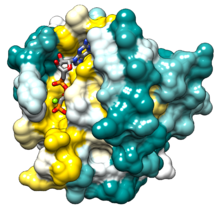GTPases are a large family of hydrolase enzymes that bind to the nucleotide guanosine triphosphate (GTP) and hydrolyze it to guanosine diphosphate (GDP). The GTP binding and hydrolysis takes place in the highly conserved P-loop "G domain", a protein domain common to many GTPases.
Small GTPases, also known as small G-proteins, are a family of hydrolase enzymes that can bind and hydrolyze guanosine triphosphate (GTP). They are a type of G-protein found in the cytosol that are homologous to the alpha subunit of heterotrimeric G-proteins, but unlike the alpha subunit of G proteins, a small GTPase can function independently as a hydrolase enzyme to bind to and hydrolyze a guanosine triphosphate (GTP) to form guanosine diphosphate (GDP). The best-known members are the Ras GTPases and hence they are sometimes called Ras subfamily GTPases.

ADP ribosylation factors (ARFs) are members of the ARF family of GTP-binding proteins of the Ras superfamily. ARF family proteins are ubiquitous in eukaryotic cells, and six highly conserved members of the family have been identified in mammalian cells. Although ARFs are soluble, they generally associate with membranes because of N-terminus myristoylation. They function as regulators of vesicular traffic and actin remodelling.

Guanine nucleotide exchange factors (GEFs) are proteins or protein domains that activate monomeric GTPases by stimulating the release of guanosine diphosphate (GDP) to allow binding of guanosine triphosphate (GTP). A variety of unrelated structural domains have been shown to exhibit guanine nucleotide exchange activity. Some GEFs can activate multiple GTPases while others are specific to a single GTPase.
The Rho family of GTPases is a family of small signaling G proteins, and is a subfamily of the Ras superfamily. The members of the Rho GTPase family have been shown to regulate many aspects of intracellular actin dynamics, and are found in all eukaryotic kingdoms, including yeasts and some plants. Three members of the family have been studied in detail: Cdc42, Rac1, and RhoA. All G proteins are "molecular switches", and Rho proteins play a role in organelle development, cytoskeletal dynamics, cell movement, and other common cellular functions.

Adenylylation, more commonly known as AMPylation, is a process in which an adenosine monophosphate (AMP) molecule is covalently attached to the amino acid side chain of a protein. This covalent addition of AMP to a hydroxyl side chain of the protein is a posttranslational modification. Adenylylation involves a phosphodiester bond between a hydroxyl group of the molecule undergoing adenylylation, and the phosphate group of the adenosine monophosphate nucleotide. Enzymes that are capable of catalyzing this process are called AMPylators.

Ras-related protein Ral-A (RalA) is a protein that in humans is encoded by the RALA gene on chromosome 7. This protein is one of two paralogs of the Ral protein, the other being RalB, and part of the Ras GTPase family. RalA functions as a molecular switch to activate a number of biological processes, majorly cell division and transport, via signaling pathways. Its biological role thus implicates it in many cancers.
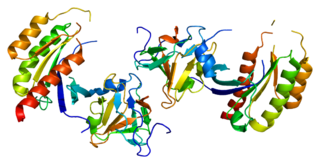
Ras-related protein Rab-8A is a protein that in humans is encoded by the RAB8A gene.

RhoG is a small monomeric GTP-binding protein, and is an important component of many intracellular signalling pathways. It is a member of the Rac subfamily of the Rho family of small G proteins and is encoded by the gene RHOG.

ADP-ribosylation factor 4 is a protein that in humans is encoded by the ARF4 gene.
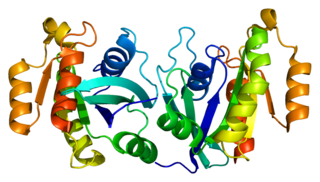
Ras-related protein Rab-11B is a protein that in humans is encoded by the RAB11B gene. Rab11b is reported as most abundantly expressed in brain, heart and testes.

Arf-GAP with Rho-GAP domain, ANK repeat and PH domain-containing protein 1 is a protein that in humans is encoded by the ARAP1 gene.

Ras-related protein Rab-33A is a protein that in humans is encoded by the RAB33A gene.
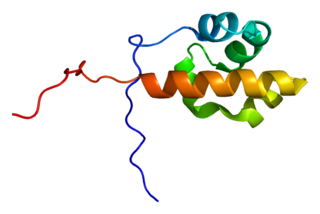
Arf-GAP with Rho-GAP domain, ANK repeat and PH domain-containing protein 2 is a protein that in humans is encoded by the ARAP2 gene.
The RhoBTB family is a subgroup of the Rho family of small GTPases. They are a highly divergent class and are all characterized by an N-terminal Rho-related domain followed by at least one C-terminal BTB domain.
GTPase-activator protein for Ras-like GTPase is a family of evolutionarily related proteins.

Ras and EF-hand domain-containing protein also known as Ras-related protein Rab-45 is a protein that in humans is encoded by the RASEF gene.

Alan Hall FRS was a British cell biologist and a biology professor at the Sloan-Kettering Institute, where he was chair of the Cell Biology program. Hall was elected a Fellow of the Royal Society in 1999.
The TBC (Tre-2/Bub2/Cdc16) is identified as a domain of some proteins or as a protein motif and widely recognized as a conserved one that includes approximately 200 amino acids in all eukaryotes.
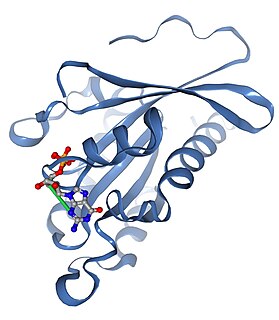
Ras-related protein Rab-2B is a protein that in humans is encoded by the RAB2B gene.
